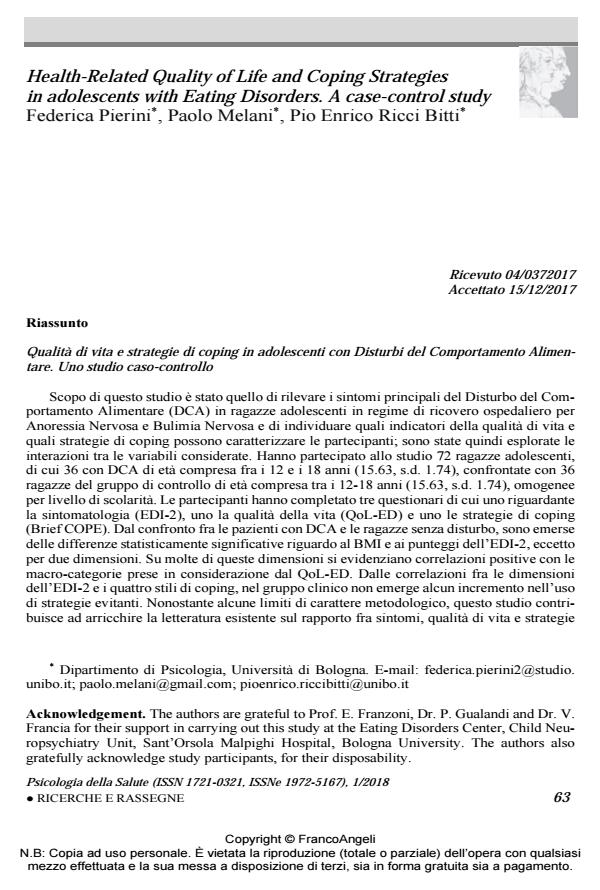Health-Related Quality of Life and Coping Strategies in adolescents with Eating Disorders. A case-control study
Journal title PSICOLOGIA DELLA SALUTE
Author/s Federica Pierini, Paolo Melani, Pio Enrico Ricci Bitti
Publishing Year 2018 Issue 2018/1
Language English Pages 18 P. 63-80 File size 246 KB
DOI 10.3280/PDS2018-001004
DOI is like a bar code for intellectual property: to have more infomation
click here
Below, you can see the article first page
If you want to buy this article in PDF format, you can do it, following the instructions to buy download credits

FrancoAngeli is member of Publishers International Linking Association, Inc (PILA), a not-for-profit association which run the CrossRef service enabling links to and from online scholarly content.
The aim of this study was to examine Eating Disorders (ED) symptoms in adolescent girls hospitalized for Anorexia Nervosa (AN) and Bulimia Nervosa (BN) and to determine which Health-Related Quality of Life (HRQoL) indicators and coping strategies can characterize ED participants; correlations between these variables were explored. Methods: The study sample is composed of 72 adolescent girls; 36 ED females aged 12-18 years (mean age 15.63 years; s.d. 1.74), compared with 36 healthy controls aged 12-18 years (mean age 15.63 years; s.d. 1.74), also matched for education level. Participants completed three questionnaires measuring ED symptoms (EDI-2), Health-Related Quality of Life in ED (QoL ED) and coping strategies (Brief COPE). Results: Comparison between girls with an ED and healthy girls revealed significant differences in BMI and in EDI-2 scores except for two dimensions. Many of these dimensions highlighted positive correlations with the considered macro-dimensions of the QoL ED. Correlation of EDI-2 dimensions with the four styles of coping did not show an increased use of avoidance strategies in the clinical group. Conclusions: In the literature there are few studies concerning the relations among ED, Quality of life and Coping strategies. Despite the methodological limitations, such as the use of not numerous samples, this study contributes to the existing literature by deepening our knowledge on this theme and highlighting the importance of understanding possible interactions between these three constructs.
Keywords: Eating Disorders, anorexia nervosa, bulimia nervosa, quality of life, coping strategies, adolescent girls.
Federica Pierini, Paolo Melani, Pio Enrico Ricci Bitti, Health-Related Quality of Life and Coping Strategies in adolescents with Eating Disorders. A case-control study in "PSICOLOGIA DELLA SALUTE" 1/2018, pp 63-80, DOI: 10.3280/PDS2018-001004